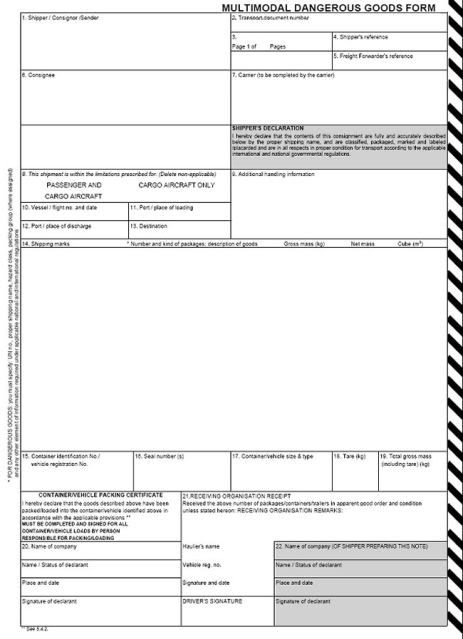fez:
I have not long passed my adr packages and yes i probably should know this but you get taught 1 way and then people tell you something different so here we go tryed to find in my book
when i collect a load of hazardous goods “container driver by the way”
{1} Do i sign the dgn when i am takeing the container to be loaded on the train ?
{2} Do i sign the dgn when i am takeing it straight to the dock to be put on a ship?
{3} Do i never have to sign a dgn ?
{4} should i always sign the dgn?Rather seem like a fool now than when i get stopped
Cheer’s in advance
Hi fez, I might not actually be the best person to help with ‘container’ questions, because I’ve never done, or even been involved with that work. I can tell you that there’s nothing in ADR itself that actually requires a registration number to be written on a transport document.
I’ll stick to the dangerous goods element of your question. ![]()
The reason you don’t know the answer to this is that it wasn’t taught as part of your ADR course. ![]()
It’s the same reason that it’s also not in your textbook. ![]()
You’ll remember the ADR definitions and responsibilities of ‘consignor’ and ‘carrier,’ and that the consignor is responsible for providing your paperwork. The carrier (your boss if you’re an employed driver) is responsible to ensure that you have copies of the paperwork.
ADR provides an example of an acceptable multi-modal DGN, so I’ve reproduced it below:
There are also other perfectly acceptable versions of DGNs, as in my answer to NEJ.

In the version above, you’ll see that the carrier completes box #7 so as the driver, you can fill in this part with details of the firm you work for.
(No need for a registration number, but you can write it in the box if you want. ![]() )
)
There are a couple of areas of a DGN which I’d suggest need to be noted by drivers…
The shipper’s declaration:
SHIPPER’S DECLARATION
I hereby declare that the contents of this consignment are fully and accurately described
below by the proper shipping name, and are classified, packaged, marked and labeled /placarded and are in all respects in proper condition for transport according to the applicable international and national governmental regulations.
![]() As a driver, I wouldn’t fancy putting my signature to that legal statement, but that’s just me…
As a driver, I wouldn’t fancy putting my signature to that legal statement, but that’s just me… ![]()
Statement in connection with BOX #20
CONTAINER/VEHICLE PACKING CERTIFICATE
I hereby declare that the goods described above have been Received the above number of packages/containers/trailers in apparent good order and condition packed/loaded into the container/vehicle identified above in accordance with the applicable provisions **
MUST BE COMPLETED AND SIGNED FOR ALL
CONTAINER/VEHICLE LOADS BY PERSON
RESPONSIBLE FOR PACKING/LOADING
As a vehicle driver, and without any additional training on load securing to the correct standards, I wouldn’t sign this part either. Or to put it another way, how would I know whether my version of securing and stowing meets the requirements mentioned in the sea transport Regs.■■
In connection with BOX #21:
21.RECEIVING ORGANISATION RECEIPT
Received the above number of packages/containers/trailers in apparent good order and condition unless stated hereon: RECEIVING ORGANISATION REMARKS:Haulier’s name
Vehicle reg. no.
Signature and date
DRIVER’S SIGNATURE
From my reading of this, the “receiving organisation” fills in this part, so, as a vehicle driver, I wouldn’t write anything here either. It seems to me that this is for the ‘consignee’ to sign.
In connection with BOX #22:
- Name of company (OF SHIPPER PREPARING THIS NOTE)
Name / Status of declarant
Place and date
Signature of declarant
You’ll notice that BOX #22 of the form above is shaded in grey, so I’d say it goes with the ‘Shipper’s Declaration’ in the other grey shaded area of the form.
As for signing the DGN, I’d say it’s a question of whether you think that the part called “driver’s signature” in the bottom center of the form above is part of BOX #21 or not.
As pointed out by OVLOV JAY in another post, ( ![]() HERE ) there’s no harm in having a separate ADR compliant ‘transport document’ to cover the part of the overall journey during wich the container is actually on board your vehicle. If you did this, there’s no requirement for either a driver’s signature or a registration number, because ADR’s requirents for a transport document are quite simple compared to IMDG’s requirements. Therefore, if you have an IMDG compliant transport document on board your vehicle, you’re far in excess of ADR’s requirements and therefore bullet-proof (transport document-wise) if you’re stopped on the road.
HERE ) there’s no harm in having a separate ADR compliant ‘transport document’ to cover the part of the overall journey during wich the container is actually on board your vehicle. If you did this, there’s no requirement for either a driver’s signature or a registration number, because ADR’s requirents for a transport document are quite simple compared to IMDG’s requirements. Therefore, if you have an IMDG compliant transport document on board your vehicle, you’re far in excess of ADR’s requirements and therefore bullet-proof (transport document-wise) if you’re stopped on the road. ![]()
fez:
Rather seem like a fool now than when i get stopped
No mate, you’re no fool, and the fact that you asked the question proves it. ![]()
I hope this helps… a bit… maybe… ![]()